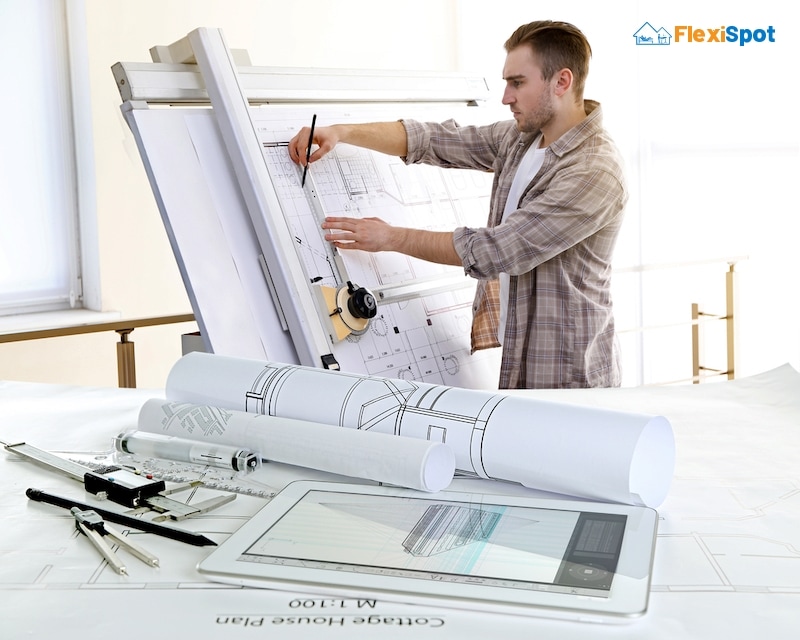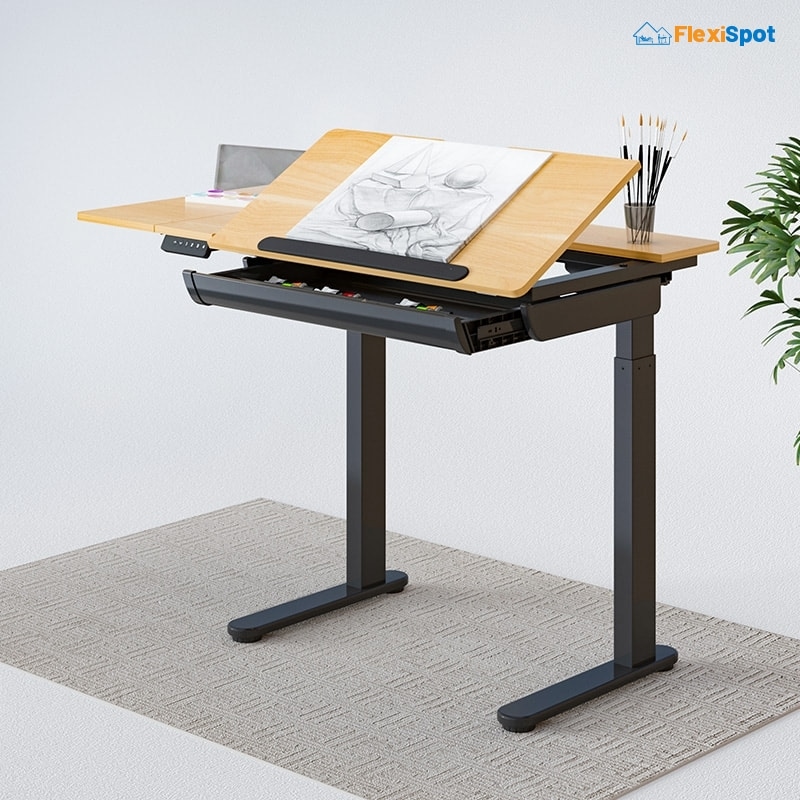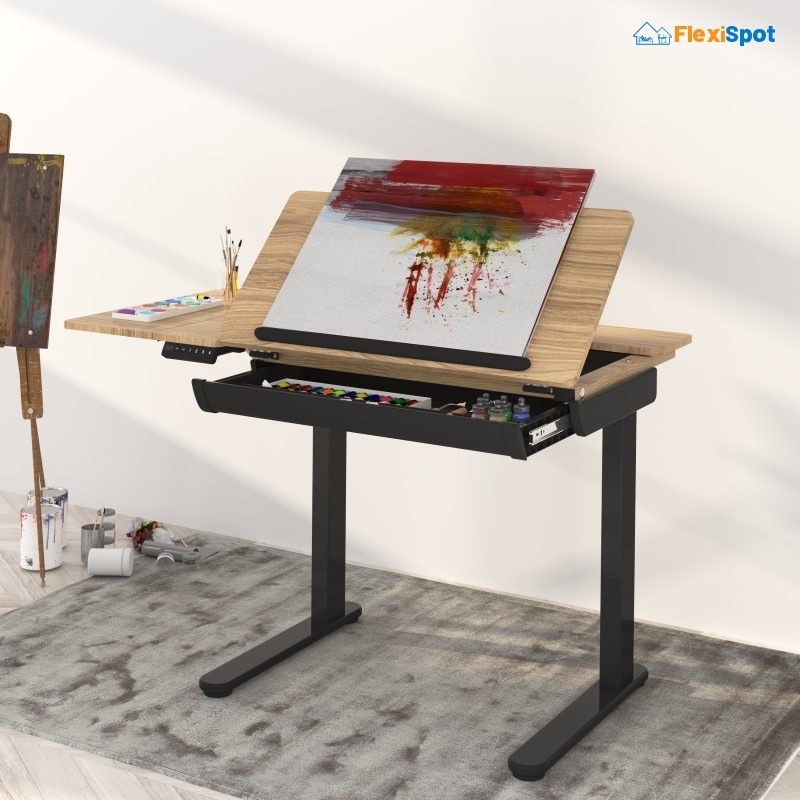A drafting table is a slanted surface used for sketching and drawing. It typically has a pencil ledge, drawers, and other storage compartments. Drafting tables are also adjustable so that the artist can change the angle of the surface to better suit their needs.
Draft tables have been around for centuries and were originally designed for architects and engineers. The slanted surface allowed for easy viewing and measuring of blueprints and other drawings. Today, drafting tables are still used by architects and engineers, but they are also popular with artists, crafters, and students.
There are many different types of drafting tables available on the market today. Some are very simple in design, while others are more elaborate. The type of drafting table you choose will depend on your budget and your needs. If you plan to use your drafting table for professional purposes, then you’re in the right place. Simply read this to the end to learn more about them.
What Is a Drafting Table?
A drafting table is a specialized type of desk or table that is typically used for drawing, sketching, or blueprinting. Drafting tables usually have a large, flat surface that can be tilted at various angles and at adjustable heights to suit the user. Many also feature built-in storage for pens, pencils, and other materials.
While a drafting table may be used by anyone who needs a stable, flat surface for drawing or sketching, they are particularly popular with architects, engineers, and other professionals who often work with blueprints or other large-scale drawings.
How Is a Drafting Table Different From a Regular Desk or Table?
A drafting table is a specialized type of desk or table that is designed for use by architects, engineers, and other professionals who need to do precision drawings. Drafting tables typically have a large, flat surface that can be tilted at various angles, making it easier to create the precise lines and angles needed for detailed drawings. Many drafting tables also have built-in storage for drawing tools and supplies and adjustable light fixtures to help illuminate the work surface.
While a regular desk or table can be used for drafting purposes, it is not ideal because the surface is not usually large enough or flat enough to provide the necessary workspace. Additionally, regular desks and tables do not typically have the same storage or lighting features found on a drafting table. For these reasons, professionals who do a lot of precision drawing typically invest in a quality drafting table.
What Are the Benefits of Using a Drafting Table?
If you're an artist, architect, or graphic designer, you know how important it is to have a good drafting table. A drafting table is a specialized piece of furniture that's designed to provide a stable, flat surface for drawing and sketching. Drafting tables also typically have adjustable surfaces so you can customize the angle at which you work.
There are many benefits to using a drafting table, including:
1. They provide a sturdy, stable surface for drawing and sketching because they are usually made from heavy-duty materials such as steel or wood. Drafting tables also have a smooth surface, which makes it easy to slide the paper around and get a clean line when drawing. Some drafting tables also come with special features such as built-in storage shelves or drawers, which can be handy for keeping all of your art supplies organized. And if you're looking for a more permanent solution, some drafting tables can even be bolted to the floor or wall.
2. The adjustable surfaces on most drafting tables allow you to customize your working angle: This can be an advantage when you are trying to get the perfect view of your work. By adjusting the surface, you can position yourself in the most comfortable way for your project. This also allows you to work on projects from different angles, which can be helpful when you are trying to get a different perspective.
3. Drafting tables are specifically designed for artists, architects, and graphic designers: Using a drafting table gives artists, architects, and graphic designers a significant advantage when working on projects requiring high precision. The large, flat surface of the table allows for plenty of space to work, and the adjustable height makes it easy to find the perfect working position. Having all of the necessary supplies close at hand is also a huge benefit, as it eliminates the need to stop and search for things when working.
4. Drafting tables are relatively inexpensive, especially compared to other pieces of artist furniture, making them an advantage for those on a budget. Drafting tables can be found at most major retailers and many online stores. There are many styles to choose from, so it is easy to find one that fits your needs. Many drafting tables come with storage shelves or drawers, which is convenient for keeping supplies close at hand. Some even have built-in light boxes, which can greatly help when working on detailed projects.
How Do I Choose the Right Drafting Table for My Needs?
There are a few key factors you'll want to keep in mind when shopping for a drafting table. By considering things like the size of the tabletop, the type of materials used, and the adjustability of the surface, you can find a great fit for your individual needs.
1. Tabletop Size: One of the most important aspects of any drafting table is the size of the tabletop. You'll want to ensure that the surface is large enough to comfortably accommodate all of your materials and give you plenty of room to work.
2. Type of Materials: The materials used in your drafting table construction are also important to consider. Some tables are made entirely of wood, while others may have a metal frame with a wooden or laminate top.
3. Adjustability: The ability to adjust the angle of the tabletop is another important factor to consider. This can be especially helpful if you use the table for drawing and writing tasks.
4. Storage Options: Another thing to remember is the storage options available on the drafting table. Some tables have built-in shelves or cabinets, while others have more limited storage options.
5. Price: Of course, you'll also want to consider the price when choosing a drafting table. Drafting tables can range in price from a few hundred dollars to several thousand, so it's important to find one that fits within your budget.
6. Assembly: Another thing to think about is the assembly required for the drafting table. Some tables come pre-assembled, while others must be put together after purchase.
7. Warranty: Finally, you'll want to consider the warranty when choosing a drafting table. Some manufacturers offer warranties of up to 10 years, so it's important to find one that offers a good level of coverage.
By keeping these factors in mind, you can be sure to find the perfect drafting table for your needs. Whether you're looking for a simple table for occasional tasks or a more elaborate model for professional use, there's sure to be an option perfect for you.
What Are Some Things to Keep In Mind When Using a Drafting Table?
When using a drafting table, it is important to keep a few things in mind to make the most of the experience. First, it is important to adjust the height of the table to be comfortable for the individual. Second, the angle of the tabletop can be adjusted to better suit the user's needs - whether it be for writing, drawing, or using a computer.
Third, the light source should be considered when using a drafting table - sunlight is often the best option, but artificial light can also be used. Finally, it is important to have a comfortable chair to sit in a while using the drafting table, as this will make the experience much more enjoyable.
What Are the Limitations of Using Drafting Tables?
While drafting tables are a great option for those needing a large, sturdy work surface, they have some limitations. First, drafting tables are not typically adjustable, so if you need to change the height of your work surface, you'll need to get a new table.
Second, because they're so big and heavy, drafting tables can be difficult to move around, so if you need to change the location of your workstation frequently, a drafting table may not be the best option. Finally, because they're designed for use with drafting tools like T-squares and protractors, they may not be the best choice if you're looking for a general-purpose work table.
Conclusion
So there you have it, the detailed look at drafting tables and how to best use them. Finding the right desk for your needs may be a little complicated, but we are here for you. You can check out our drafting tables catalog on our website. Furthermore, if you have any questions, you can drop us an email, and we will be more than happy to take care of your needs.




